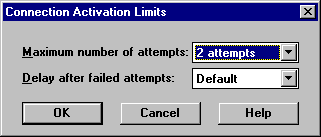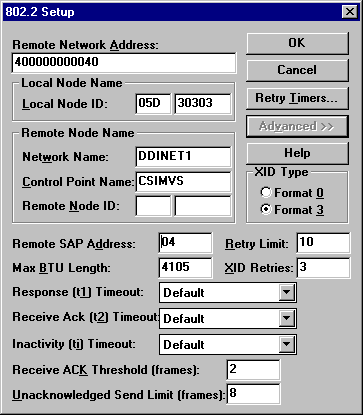Now display the 802.2 Setup dialog box by clicking on the Setup button in the Connection Properties dialog box.
- Enter the 12 digit hexadecimal Remote Network Address of the network controller attached to the remote host system. This should be obtained from the network administrator of the host system.
- Enter the 8 digit hexadecimal Local Node ID which is used to identify this local system on the SNA network. The first 3 digits is the block (IDBLK) number followed by the last 5 digits of the node (IDNUM) number. These numbers must correspond with the IDBLK and IDNUM fields of the PU definition for this machine as defined in VTAM on the host system.
- At this point you must check with the network administrator of the host system to see whether the host system uses Format 3 type XIDs.
- If it does then you must fill in the Network Name and Control Point name of the host system.
- If it does not use Format 3 XIDs (usually the case) then these fields can be left blank.
- Also check with the network administrator of the host system whether the Node Id of the host system should be configured. If so, enter the 8 digit block number and node number given to you by the network administrator of the host system which is the Remote Node Id of the host system.
- Now set the connection retry parameters by clicking on the Retry Timers button.
- Set a value for the Maximum Number of attempts that SNA Server will make to establish the connection with the host system. The possible values range from 1 to Unlimited. We suggest a value of 2.
- Set a value for the Delay after failed attempts. This is a value in seconds between each attempt. The range is from 5 to 255 seconds, with a default of 10.

- Now check the Advanced settings for the 802.2 connection by clicking the Advanced button.
The Advanced settings contains parameters which in most cases can be left to their default values. Two which may need modification are the BTU Length and the XID Type.
- Specify a value for the maximum BTU Length based on the following formula. BTU = MAXDATA - 9, where MAXDATA is the value of the MAXDATA parameter of the PU definition for this machine. NOTE: For a 4 Mbs Token Ring specify a BTU value of 4195 or less. For a 16 Mbs Token Ring specify a value of 16393 or less. For an Ethernet LAN specify a BTU value of 1493 or less.
- The XID Type should reflect the type used by the host system. Format 0 only sends the local Node ID and is used only when hosts do not support the default Format 3 XID. Format 3 sends up to 100 bytes of identification data which includes the local Node ID and the Control Point name. Independent APPC LUs must use format 3 XIDs. The default is Format 3.
- To complete the configuration of the connection click on the OK button.

Before attempting to communicate using CCIAPPC you must define the local and remote LUs which will be used to communicate over the SNA connection you have configured. In this section we will describe the configuration of Independent LUs to be used to communicate over the host connection. When communicating with Host systems running VTAM (or NCP) the Remote LU is known as the APPLID (pronounced 'apple-id').










